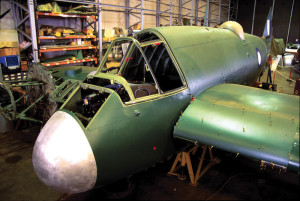Apologies if I appear to be raining on your parade, but there are a few details that can be added to make the Beaufighter more representative of a Coastal Command TF. X should you wish.
Both decal options, 236 Sqn MB-T and 254 Sqn QM-F, were part of the North Coates Strike Wing along with 144 Sqn. 144 & 236 Sqn were assigned the flak suppression role, attacking the escorts, flak ships and and merchantmen with rockets and 20mm cannon generally raising havoc with the flak crews clearing the way for torpedo armed 254 Sqn to attack the merchantmen. Although all TF.X aircraft were capable of carrying rockets, bombs or torpedoes, because of the specialized "art" of employing rockets and torpedoes, each squadron's aircraft were configured for their assigned role and trained accordingly. Thus, 144 & 236 Sqn aircraft had the rocket plates installed on the wings and didn't carry torpedoes. 254 Sqn aircraft were configured for torpedo carriage without the rocket plates. Both configurations were still capable of having the Universal Bomb Racks installed and were for practice, they don't seem to have been used operationally by Coastal Command.
While we are here, the yellow colour of the codes "MB-T" for the 236 Sqn aircraft are questionable. The colours officially in use with the Dark Sea Grey over Sky scheme were 36" Dark Dull Red characters with a thin Yellow outline when flanking the roundel and 24" Sky characters when placed forward of the roundel, centred over the wing.
The second option for 254 Sqn "QM-F" is a mixed bag of markings. The Dull Red codes would be correct for late 1944 and into 1945. The Black underwing serials appeared post-war. The upper wing Type B roundels are correct until the end of 1944. In January 1945 the RAF ordered the change to Type C roundels on the upper wing. Also in early 1945 Coastal Command began changing the ID codes to Black. I'm not sure if the thin White and Red tail bands were a late war or post war addition. Using the Dull Red codes without the underwing serials, Type B wing roundels and maybe the tailbands it could be a late 1944 aircraft. Moving into early 1945 would require type C wing roundels without underwing serials, Black ID codes and maybe the the tailbands. A post war aircraft would have the underwing serial added and the tailbands.
These are some TF.X features:
- The port wing landing lights had the Perspex removed and were faired over with aluminium sheet on rocket configured aircraft.
- 25 lb or 60 lb rockets could be used. 25 lb rock had a flatter trajectory, the 60 lb rockets had to be lobbed because of the warhead weight. The 60 lb warhead was originally designed for anti-shipping and the 25 lb warhead for anti-tank. Coastal Command found the 25 lb solid shot more effective as the warhead would penetrate the hull, the still burning rocket motor would break off in the hull and the warhead would continue on, often exiting out the other side of the hull. 2 TAF found the 60 lb warhead more effective when attacking ground targets. (kit has 25 lb rockets)
- All aircraft retained the torpedo crutches (sway braces) but the locating socket (wedge shaped piece on the belly crew access door) was removed on rocket configured aircraft. A 200 gal drop tank could be carried, it was tested but doesn't seem to have been used operationally in Coastal Command. (the crutches will have to be cut from the torpedo)
- Wing and fuselage universal bomb racks could be installed but were rarely seen (there are photos of a 254 Sqn acft being tested with bombs at A&AEE and a 404 Sqn acft with fuselage bomb racks).
- A nose mounted strike camera was fitted. (missing from kit)
- A long lens strike camera could be installed when required for a mission by switching noses caps. (missing from kit)
- Thimble nosed TF.X's had the strike camera installed in a fairing on the upper fuselage just aft of the cockpit. (missing from the kit)
- Some aircraft retained a gun camera in the LH wing leading edge, outboard of the oil cooler intake.
- Additional wing fuel tanks were installed in the wing gun bays with the gun ports plugged or faired over with fabric and dope. The guns could be reinstalled but required the removal of the rocket rail plate as the plate covered the ejector ports.
- Antenna configurations changed depending on the mod packages fitted for equipment fitted (GEE, ASV, REBECCA, etc).
- A ram air venturi box was installed forward of the windscreen to improve de-icing/cleaning (included in the kit)
- When installed, the torpedo had a plywood Aerotail installed that improved aerodynamics, stabilizing it during release and the drop. It broke off upon impacting the water. (missing from kit)
NT950 in flight. It has the venturi box, whisker antennas just aft of the nose cap, antennas under the tail planes and the wing gun ports and landing light are covered.
A colorized picture of a 404 Sqn (RCAF) TF.X with the long lens strike camera and the wing gun camera.
A late production (thimble nose) TF.X with the upper fuselage strike camera. They were sometimes removed post war. It also appears to have the wing gun camera.
As we all know, it can be a minefield when it comes to knowing what mods were incorporated and when either on the production line on while in service. There is a laundry list of tweaks and details that can be added if you are an AMS afflicted Beaufighter fan to the Tamiya Beaufighter family, from interior details to major surgery correcting the tail planes and aft fuselage.
For your consideration.
Cheers,
RichB



